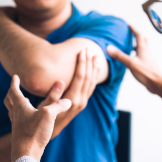
The bony knob on the outside of your elbow starts aching and radiating pain through your arm. Is it just a fluke? Did you hurt yourself? If you start feeling pain and tenderness regularly, you may have a condition called tennis elbow.
The scientific name for tennis elbow is lateral epicondylitis and it occurs when joint overuse causes inflammation and small tears in tendons. The anatomy of the elbow is complex. It is a relatively small joint, but the elbow serves as a hub for many important ligaments and tendons, including your arms’ biceps and triceps. Repetitive use of the elbow causes strain, inflammation, and sometimes damage to the joint, which is why tennis elbow can cause pain throughout your entire arm.
“Not surprisingly, playing tennis or other racquet sports can cause this condition. However, several other activities besides sports can also put you at risk,” writes the American Academy of Orthopedic Surgeons.
Beyond athletes, tennis elbow is common in people whose jobs require repeated cranking, sweeping, or jarring motions like plumbers, butchers, mechanics, and painters. Many office workers suffer from tennis elbow as well, with the primary culprit being the computer mouse. Depending on your course of treatment, tennis elbow can be improved in six months to two years.
Best Treatment for Tennis Elbow, Before Considering Surgery
The documented success rate for tennis elbow surgery is excellent. However, there are several effective ways to improve overall elbow joint health without surgery, such as:
- Tennis elbow brace. By applying pressure to the muscles below the joint, braces can provide temporary relief from symptoms by allowing the arm and joint to rest. There are many elbow braces on the market. Work with your doctor to find the right brace for your condition.
- Steroid injections. Reducing inflammation is a key goal when treating tennis elbow. Steroid injections are highly effective at mitigating inflammation. However, recent studies show that steroids can disrupt the healing of the joint. Talk to your doctor about the pros and cons of steroid injections for tennis elbow.
- Massage. Deep friction massage helps to reduce tension in muscles and tissue, increases blood flow, and can reduce inflammation. Massage is an effective treatment for tennis elbow, especially for patients who have not benefitted from steroid injections and other therapies.
- Platelet Rich Plasma. This novel therapy is currently being studied heavily as it has been shown to promote healing in damaged tendons and other parts of the body. While outcomes are favorable for its use to treat tennis elbow, some insurance providers do not offer coverage because it is a new strategy. Be sure to speak with both your doctor and insurance carrier before pursuing this option.
- Acupuncture. Acupuncture has been proven to relieve pain associated with tennis elbow. However, the relief typically lasts for roughly two weeks and is not considered a long-term solution.
- Ice. Icing your elbow can be beneficial in that it will numb some of the pain and reduce swelling. You can apply ice or a cold pack for up to 15 minutes, several times a day as needed.
- Rest. Just as overuse is the cause of tennis elbow, resting the joint improves the condition. This may not be an option for people with occupational demands that do not allow for rest. Ice, bracing, and pain relief therapies can help if rest isn’t possible.
- Physical Therapy & Exercise. After your swelling and inflammation are under control, stretching and strengthening exercises are highly recommended. A physical therapist will evaluate your health status and teach you how to safely exercise your arm at home. By increasing strength and stability, you’ll be on your way to reducing your chances of a recurrence of tennis elbow.
Elbow Maintenance
If you can successfully control and improve your pain caused by tennis elbow, do not resume with activity as normal without considering how to take care of your arm, long-term. Be mindful of the risks of overuse. After strenuous or repetitive activity, give your elbow a break. Rest is not only a treatment for tennis elbow, it can also help prevent future flareups and injury. Ibuprofen and other over-the-counter anti-inflammatory medications can be used to keep irritation at bay.
Surgery for tennis elbow is rare. However, if you are still experiencing pain that lasts longer than a year despite practicing alternative treatments, talk to your surgeon about your options.